At equilibrium, ________.
A) all chemical reactions have
ceased
B) the rates of the forward and reverse reactions are
equal
C) the rate constants of the forward and reverse reactions
are equal
D) the value of the equilibrium constant is 1
E)
the limiting reagent has been consumed
B
What role did Karl Bosch play in development of the Haber-Bosch
process?
A) He discovered the reaction conditions necessary for
formation of ammonia.
B) He originally isolated ammonia from
camel dung and found a method for purifying it.
C) Haber was
working in his lab with his instructor at the time he worked out the
process.
D) He developed the equipment necessary for industrial
production of ammonia.
E) He was the German industrialist who
financed the research done by Haber.
D
Fritz Haber was awarded the ________ Nobel Prize in chemistry for his
development of a process for synthesizing ammonia directly from
nitrogen and hydrogen.
A) 1954
B) 1918
C) 1933
D)
1900
E) 1912
B
Which one of the following is true concerning the Haber
process?
A) It is a process used for shifting equilibrium
positions to the right for more economical chemical synthesis of a
variety of substances.
B) It is a process used for the synthesis
of ammonia.
C) It is another way of stating Le Châtelier's
principle.
D) It is an industrial synthesis of sodium chloride
that was discovered by Karl Haber.
E) It is a process for the
synthesis of elemental chlorine.
B
Which one of the following will change the value of an equilibrium
constant?
A) changing temperature
B) adding other substances
that do not react with any of the species involved in the
equilibrium
C) varying the initial concentrations of
reactants
D) varying the initial concentrations of
products
E) changing the volume of the reaction vessel
A
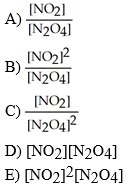
Which of the following expressions is the correct equilibrium-constant expression for the equilibrium between dinitrogen tetroxide and nitrogen dioxide?
N2O4 (g) ⇌ 2NO2 (g)
B
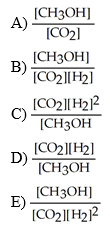
Which of the following expressions is the correct equilibrium-constant expression for the following reaction?
CO2 (g) + 2H2 (g) ⇌ CH3OH (g)
E
The equilibrium-constant expression depends on the ________ of the
reaction.
A) stoichiometry
B) mechanism
C)
stoichiometry and mechanism
D) the quantities of reactants and
products initially present
E) temperature
A
The equilibrium constant for reaction 1 is K. The equilibrium constant for reaction 2 is ________.
(1) SO2 (g) + (1/2) O2 (g) ⇌ SO3 (g)
(2) 2SO3 (g) ⇌ 2SO2 (g)
+ O2 (g)
A) K2
B) 2K
C) 1/2K
D) 1/K2
E) -K2
D

The equilibrium expression for Kp for the reaction below is ________.
2O3 (g) ⇌ 3O2 (g)
E
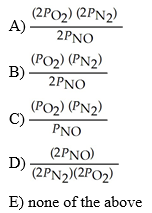
The equilibrium expression for Kp for the reaction below is ________.
N2 (g) + O2 (g) ⇌ 2NO (g)
E
The Keq for the equilibrium below is 7.52 × 10-2 at 480.0 °C.
2Cl2 (g) + 2H2O (g) ⇌ 4HCl (g) + O2 (g)
What is the value of Keq at this temperature for the following reaction?
2HCl (g) + 1/2 O2 (g) ⇌ Cl2 (g) + H2O (g)
A) 13.3
B)
3.65
C) -0.0376
D) 5.66 × 10-3
E) 0.274
B
The Keq for the equilibrium below is 5.4 × 1013 at 480.0 °C.
2NO (g) + O2 (g) ⇌ 2NO2 (g)
What is the value of Keq at this temperature for the following reaction?
2NO2 (g) ⇌ 2NO (g) + O2 (g)
A) 5.4 × 10-13
B) 1.9 × 10-14
C) 5.4 × 1013
D) 5.66 × 10-3
E) none of the above
B
The Keq for the equilibrium below is 50.
H2 (g) + I2 (g) ⇌ 2HI (g)
What is the value of Keq for the following reaction?
2HI (g) ⇌ H2 (g) + I2 (g)
A) 100
B) 0.50
C) 0.020
D) 2500
E) -50
C
The Keq for the equilibrium below is 50.
H2 (g) + I2 (g) ⇌ 2HI (g)
What is the value of Keq for the following reaction?
1/2 H2 (g) + 1/2 I2 (g) ⇌ HI (g)
A) 25
B) 2500
C) 7.07
D) 100
E) -50
C
Given the following reaction at equilibrium, if Kc = 1.90 × 1019 at 25.0 °C, Kp = ________.
H2 (g) + Br2 (g) ⇌ 2 HBr (g)
A) 5.26 ×
10-20
B) 1.56 × 104
C) 6.44 ×
105
D) 1.90 × 1019
E) none of the above
D
Which of the following expressions is the correct equilibrium-constant expression for the reaction below?
2SO2 (g) + O2 (g) ⇌ 2SO3 (g)
A) [SO3] / [SO2][O2]
B) [SO2] / [SO3]
C)
[SO3]2 / [SO2]2[O2]
D) [SO3]2 /
[SO2]2[O2]2
E) [SO3] / [SO2][O2]2
C
Which of the following expressions is the correct equilibrium-constant expression for the reaction below?
(NH4)2Se (s) ⇌ 2NH3 (g) + H2Se (g)
A) [NH3][H2Se] / [(NH4)2Se]
B) [(NH4)2Se] /
[NH3]2[H2Se]
C) 1 / [(NH4)2Se]
D)
[NH3]2[H2Se]
E) [NH3]2[H2Se] / [(NH4)2Se]
D
Which of the following expressions is the correct equilibrium-constant expression for the reaction below?
CO2 (s) + H2O (l) ⇌ H+ (aq) + HCO3- (aq)
A) [H+][HCO3-] / [CO2]
B) [CO2] / [H+][HCO3-]
C)
[H+][HCO3-] / [CO2][H2O]
D) [CO2][H2O] / [H+][HCO3-]
E) [H+][HCO3-]
E
Which of the following expressions is the correct equilibrium-constant expression for the reaction below?
HF (aq) + H2O (l) ⇌ H3O+ (aq) + F- (aq)
A) [HF][H2O] / [H3O+][F-]
B) 1 / [HF]
C) [H3O+][F-] /
[HF][H2O]
D) [H3O+][F-] / [HF]
E) [F-] / [HF]
D
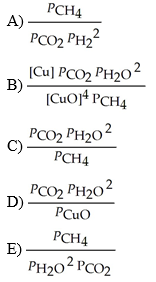
The expression for for the reaction below is ________.
4CuO (s) + CH4 (g) ⇌ CO2 (g) + 4Cu (s) + 2H2O (g)
C
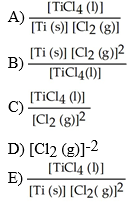
The equilibrium-constant expression for the reaction
Ti (s) + 2Cl2 (g) ⇌ TiCl4 (l)
D
The equilibrium constant for the gas phase reaction
N2 (g) + 3H2 (g) ⇌ 2NH3 (g)
is Keq = 4.34 × 10-3 at 300 °C. At
equilibrium, ________.
A) products predominate
B) reactants
predominate
C) roughly equal amounts of products and reactants
are present
D) only products are present
E) only reactants
are present
B
The equilibrium constant for the gas phase reaction
2SO2 (g) + O2 (g) ⇌ 2SO3 (g)
is Keq = 2.80 × 102 at 999 K. At equilibrium,
________.
A) products predominate
B) reactants
predominate
C) roughly equal amounts of products and reactants
are present
D) only products are present
E) only reactants
are present
A
The equilibrium constant for the gas phase reaction
2NH3 (g) ⇌ N2 (g) + 3H2 (g)
is Keq = 230 at 300 °C. At equilibrium,
________.
A) products predominate
B) reactants
predominate
C) roughly equal amounts of products and reactants
are present
D) only products are present
E) only reactants
are present
A
The equilibrium constant for the gas phase reaction
H2 (g) + I2 (g) ⇌ 2HI (g)
is Keq = 50 at 25 °C. At equilibrium, ________.
A)
products predominate
B) reactants predominate
C) roughly
equal amounts of products and reactants are present
D) only
products are present
E) only reactants are present
A
The equilibrium constant for the gas phase reaction
2SO3 (g) ⇌ 2SO2 (g) + O2 (g)
is Keq = 3.6 × 10-3 at 999 K. At equilibrium,
________.
A) products predominate
B) reactants
predominate
C) roughly equal amounts of products and reactants
are present
D) only products are present
E) only reactants
are present
B
At 400 K, the equilibrium constant for the reaction
Br2 (g) + Cl2 (g) ⇌ 2BrCl (g)
is Kp = 7.0. A closed vessel at 400 K is charged with 1.00 atm of
Br2 (g), 1.00 atm of Cl2 (g), and 2.00 atm of BrCl (g). Use Q to
determine which of the statements below is true.
A) The
equilibrium partial pressures of Br2, Cl2, and BrCl will be the same
as the initial values.
B) The equilibrium partial pressure of
BrCl (g) will be 4.00 atm.
C) The equilibrium partial pressure
of Br2 will be greater than 1.00 atm.
D) At equilibrium, the
total pressure in the vessel will be less than the initial total
pressure.
E) The reaction will go to completion since there are
equal amounts of Br2 and Cl2.
B
Which of the following statements is true?
A) Q does not change
with temperature.
B) Keq does not change with temperature,
whereas Q is temperature dependent.
C) K does not depend on the
concentrations or partial pressures of reaction components.
D) Q
does not depend on the concentrations or partial pressures of reaction
components.
E) Q is the same as Keq when a reaction is at equilibrium
E
How is the reaction quotient used to determine whether a system is at
equilibrium?
A) The reaction quotient must be satisfied for
equilibrium to be achieved.
B) At equilibrium, the reaction
quotient is undefined.
C) The reaction is at equilibrium when Q
< Keq.
D) The reaction is at equilibrium when Q >
Keq.
E) The reaction is at equilibrium when Q = Keq.
E
Which reaction will shift to the left in response to a decrease in
volume?
A) 2HI (g) ⇌ H2 (g) + I2 (g)
B) H2 (g) + Cl2 (g) ⇌
2 HCl (g)
C) N2 (g) + 3H2 (g) ⇌ 2 NH3 (g)
D) 2 SO3 (g) ⇌ 2
SO2 (g) + O2 (g)
E) 4 Fe (s) + 3 O2 (g) ⇌ 2 Fe2O3 (s)
D
Which reaction will shift to the right in response to a decrease in
volume?
A) N2 (g) + 3H2 (g) ⇌ 2NH3 (g)
B) H2 (g) + Cl2 (g) ⇌
2 HCl (g)
C) 2 SO3 (g) ⇌ 2 SO2 (g) + O2 (g)
D) 2HI (g) ⇌ H2
(g) + I2 (g)
E) 2 Fe2O3 (s) ⇌ 4 Fe (s) + 3O2 (g)
A
Based on Le Châtelier's principle, increasing pressure at constant
temperature in the following reaction will not change the
concentrations of reactants and products.
A) N2O4 (g) ⇌ 2NO2
(g)
B) N2 (g) + O2 (g) ⇌ 2NO (g)
C) N2 (g) + 2O2 (g) ⇌ 2NO2
(g)
D) N2 (g) + 3H2 (g) ⇌ 2NH3 (g)
E) 2N2 (g) + O2 (g) ⇌
2N2O (g)
B
In which of the following reactions would increasing pressure at
constant temperature change the concentrations of reactants and
products, based on Le Châteliers principle?
A) N2 (g) + 3H2 (g) ⇌
2NH3 (g)
B) N2O4 (g) ⇌ 2NO2 (g)
C) N2 (g) + 2O2 (g) ⇌ 2NO2
(g)
D) 2N2 (g) + O2 (g) ⇌ 2 O (g)
E) all of the above
E
Consider the following reaction at equilibrium:
2NH3 (g) ⇌ N2 (g) + 3H2 (g)
Le Châtelier's principle predicts that the moles of in the reaction
container will increase with ________.
A) some removal of from
the reaction vessel (V and T constant)
B) a decrease in the total
pressure (T constant)
C) addition of some to the reaction vessel
(V and T constant)
D) a decrease in the total volume of the
reaction vessel (T constant)
E) an increase in total pressure by
the addition of helium gas (V and T constant)
B
Consider the following reaction at equilibrium:
2CO2 (g) ⇌ 2CO (g) + O2 (g) ΔH° = -514 kJ
Le Châtelier's principle predicts that a decrease in temperature
will ________.
A) decrease the partial pressure of O2 (g)
B)
increase the partial pressure of CO2 (g)
C) decrease the value of
the equilibrium constant
D) increase the value of the equilibrium
constant
E) decrease the partial pressure of CO
D
Consider the following reaction at equilibrium.
2CO2 (g) ⇌ 2CO (g) + O2 (g) ΔH° = -514 kJ
Le Châtelier's principle predicts that the equilibrium partial
pressure of CO (g) can be maximized by carrying out the reaction
________.
A) at high temperature and high pressure
B) at
high temperature and low pressure
C) at low temperature and low
pressure
D) at low temperature and high pressure
E) in the
presence of solid carbon
C
The effect of a catalyst on an equilibrium is to ________.
A)
increase the rate of the forward reaction only
B) increase the
equilibrium constant so that products are favored
C) slow the
reverse reaction only
D) increase the rate at which equilibrium
is achieved without changing the composition of the equilibrium
mixture
E) shift the equilibrium to the right
D
The value of Keq for the equilibrium
H2 (g) + I2 (g) ⇌ 2HI (g)
is 794 at 25 °C. What is the value of Keq for the equilibrium below?
1/2 H2 (g) + 1/2 I2 (g) ⇌ HI (g)
A) 397
B) 0.035
C) 28
D) 1588
E) 0.0013
C
The value of Keq for the equilibrium
H2 (g) + I2 (g) ⇌ 2HI (g)
is 794 at 25 °C. At this temperature, what is the value of Keq for the equilibrium below?
HI (g) ⇌ 1/2 H2 (g) + 1/2 I2 (g)
A) 1588
B) 28
C) 397
D) 0.035
E) 0.0013
D
The value of Keq for the equilibrium
H2 (g) + I2 (g) ⇌ 2HI (g)
is 54.0 at 427 °C. What is the value of Keq for the equilibrium below?
HI (g) ⇌ 1/2 H2 (g) + 1/2 I2(g)
A) 27
B) 7.35
C) 0.136
D) 2.92 × 103
E) 3.43 × 10-4
C
The value of Keq for the equilibrium
CO2 (g) + 2H2 (g) ⇌ CH3OH (g)
is 14.5 at 483 °C. What is the value of Keq for the equilibrium below?
1/2 CO2 + H2 (g) ⇌ 1/2 CH3OH (g)
A) 7.30
B) 7.35
C) 0.136
D) 3.81
E) 6.90 × 10-2
D
The value of Keq for the equilibrium
N2 (g) + O2 (g) ⇌ 2 NO (g)
is 4.2 × 10-31 at 27 °C. What is the value of Keq for the equilibrium below?
4 NO (g) ⇌ 2 N2 (g) + 2 O2 (g)
A) 5.7 × 1060
B) 8.4 × 10-31
C)
4.2 × 1031
D) 8.4 × 1031
E) none
of the above
A
Consider the following chemical reaction:
CO (g) + 2H2(g) ⇌ CH3OH(g)
At equilibrium in a particular experiment, the concentrations of CO
and H2 were 0.15M and 0.36M, respectively. What is the equilibrium
concentration of CH3OH? The value of Keq for this reaction
is 14.5 at the temperature of the experiment.
A) 14.5
B)
7.61 × 10-3
C) 2.82 × 10-1
D) 3.72
× 10-3
E) 1.34 × 10-3
C
A reaction vessel is charged with hydrogen iodide, which partially decomposes to molecular hydrogen and iodine:
2HI (g) ⇌ H2(g) + I2(g)
When the system comes to equilibrium at 425 °C, PHI = 0.708 atm,
and PH2=PI2=0.0960atm. The value of Kp at this temperature is
________.
A) 6.80 × 10-2
B) 1.30 ×
10-2
C) 54.3
D) 1.84 × 10-2
E) Kp cannot be calculated for this gas reaction when the volume
of the reaction vessel is not given.
D
Acetic acid is a weak acid that dissociates into the acetate ion and a proton in aqueous solution:
HC2H3O2 (aq) ⇌ C2H3O2- (aq) + H+ (aq)
At equilibrium at 25 °C a 0.100 M solution of acetic acid has the
following concentrations: |HC2H302| = 0.0990M, |C2H302-| = 1.33 X
10-3M, and |H+| = 1.33 X 10-3M. The equilibrium
constant, Keq, for the ionization of acetic acid at is
________.
A) 5.71 × 104
B) 0.100
C) 1.75 ×
10-7
D) 1.79 × 10-5
E) 5.71 × 106
D
Dinitrogentetraoxide partially decomposes into nitrogen dioxide. A
1.00-L flask is charged with 0.0400 mol of N2O4. At equilibrium at 373
K, 0.0055 mol of N2O4 remains. Keq for this reaction is
________.
A) 2.2 × 10-4
B) 13
C)
0.22
D) 0.87
E) 0.022
D
In an experiment, 0.42 mol of CO and 0.42 mol of H2 were placed in a
1.00-L reaction vessel to yield CH3OH. At equilibrium, there were 0.29
mol of CO remaining. Keq at the temperature of the
experiment is ________.
A) 2.80
B) 17.5
C)
0.357
D) 14.5
E) none of the above
B
A sealed 1.0 L flask is charged with 0.500 mol of I2 and 0.500 mol of Br2. An equilibrium reaction ensues:
I2 (g) + Br2 (g) ⇌ 2IBr (g)
When the container contents achieve equilibrium, the flask contains
0.84 mol of IBr. The value of Keq is ________.
A)
11
B) 4.0
C) 110
D) 6.1
E) 2.8
C
The equilibrium constant (Kp) for the interconversion of PCl5 and
PCl3 is 0.0121. A vessel is charged with PCl5 giving an initial
pressure of 0.123 atm and yields PCl3 and Cl2. At equilibrium, the
partial pressure of PCl3 is ________ atm.
A) 0.0782
B)
0.0330
C) 0.0908
D) 0.0455
E) 0.123
B
At 200 °C, the equilibrium constant (Kp) for the conversion of NO to
oxygen and nitrogen gas is 2.40 × 103. A closed vessel is
charged with 36.1 atm of NO. At equilibrium, the partial pressure of
O2 is ________ atm.
A) 294
B) 6.00
C) 35.7
D) 1.50
× 10-2
E) 17.9
E
Which of the following expressions is the correct equilibrium-constant expression for the equilibrium between dinitrogen tetroxide and nitrogen dioxide?
5N2O4(g) ⇌ 10NO2 (g)
A) [NO2]10/[N2O4]5
B)
[N2O4]10/[NO2]5
C)
[NO2]5/[N2O4]10
D)
[NO2]5/[N2O4]5
E) [N2O4]5/[NO2]5
A
Given the following reaction at equilibrium, if Kc = 5.84 x 105 at 230.0 °C, Kp = ________.
2NO (g) + O2 (g) ⇌ 2NO2(g)
A) 3.67 × 10-2
B) 1.41 × 104
C) 6.44 × 105
D) 2.40 × 106
E) 2.41 × 107
B
Given the following reaction at equilibrium at 450.0 °C:
CaCO3 (s) ⇌ CaO (s) + CO2 (g)
If pCO2 = 0.0155 atm, Kc = ________.
A) 155
B)
0.0821
C) 0.920
D) 2.61 × 10-4
E) 9.20
D
Given the following reaction at equilibrium, if Kp = 1.10 at 250.0 °C, Kc = ________.
PCl5 (g) ⇌ PCl3 (g) + Cl2 (g)
A) 3.90 ×
10-6
B) 2.56 × 10-2
C)
1.10
D) 42.9
E) 47.2
B
Given the following reaction at equilibrium at 300.0 K:
NH4HS (s) ⇌ NH3 (g) + H2S (g)
If pNH3 = pH2S = 0.105 atm, Kp = ________.
A) .0110
B)
4.99 × 10-4
C) .105
D) .0821
E) 5.66 × 10-3
A
The value of Keq for the following reaction is 0.25:
S (g) + N (g) ⇌ SO3 (g) + NO (g)
The value of Keq at the same temperature for the reaction below is ________.
3SO2 (g) + 3NO2 (g) ⇌ 3SO2 (g) + 3NO (g)
A) 1.6 × 10-2
B) 7.5 × 10-1
C)
8.3 × 10-2
D) 6.4 × 101
E) 0.25
A
The Keq for the equilibrium below is 7.52 × 10-2 at 480.0 °C.
2Cl2 (g) + 2H2O (g) ⇌ 4HCl (g) + O2 (g)
What is the value of Keq at this temperature for the following reaction?
8HCl (g) + 2O2 (g) ⇌ 4Cl2 (g) + 4H2O (g)
A) 1.77 × 102
B) 5.66 × 10-3
C)
1.50 × 10-1
D) -7.52 × 10-2
E) 7.52
× 10-2
A
The Keq for the equilibrium below is 5.4 × 1013 at 480.0 °C.
2NO (g) + O2 (g) ⇌ 2NO2 (g)
What is the value of Keq at this temperature for the following reaction?
4NO (g) + 2O2 (g) ⇌ 4NO2 (g)
A) 2.9 × 1027
B) 8.5 × 1054
C) 3.4
× 10-28
D) -1.1 × 1014
E) 5.4 × 1013
A
The Keq for the equilibrium below is 0.112 at 700.0 °C.
SO2 (g) + 1/2 O2 (g) ⇌ SO3 (g)
What is the value of
Keq at this temperature for the following reaction?
2SO2 (g) + O2 (g) ⇌ 2SO3 (g)
A) 1.25 × 10-2
B) 2.24 × 10-1
C)
7.97 × 101
D) 4.46
E) 0.112
A
The value of Keq for the following reaction is 0.26:
A (g) + B (g) ⇌ C (g) + D (g)
The value of Keq at the same temperature for the reaction below is ________.
2A (g) + 2B (g) ⇌ 2C (g) + 2D (g)
A) 0.068
B) 0.52
C) 1.2
D) 0.065
E) 0.26
A
The value of Keq for the following reaction is 0.16:
A (g) + B (g) ⇌ C (g) + D (g)
The value of Keq at the same temperature for the reaction below is ________.
3C (g) + 3D (g) ⇌ 3A (g) + 3B (g)
A) 2.4 × 102
B) 2.1
C) 4.1 × 10-3
D) 5.3 × 10-2
E) 6.3
A
The value of Keq for the following reaction is 0.50:
A (g) + 2B (g) ⇌ C (g) + 4D (g)
The value of Keq at the same temperature for the reaction below is ________.
1/2A (g) + B (g) ⇌ 1/2C (g) + 2D (g)
A) 7.1 × 10-1
B) 2.5 × 10-1
C)
0.25
D) 1.0
E) 0.50
A
The Keq for the equilibrium below is 7.16 × 10-2 at 440.0 °C.
2Cl2 (g) + 2H2O (g) ⇌ 4HCl (g) + O2 (g)
What is the value of Keq at this temperature for the
following reaction?
Cl2 (g) + H2O (g) ⇌ 2HCl (g) + 1/2 O2
(g)
A) 0.0716
B) 5.13 × 10-3
C) 0.268
D) 0.0376
E) 0.150
C
At 1000.0 K, the equilibrium constant for the reaction
2NO (g) + Br2 (g) ⇌ 2NOBr (g)
is Kp = 0.016. Calculate Kp for the reverse reaction,
2NOBr (g) ⇌ 2NO (g) + Br2 (g).
A) 0.016
B) 1.6 × 10-4
C) 63
D) 0.99
E) 1.1
C
The expression of Keq for the following reaction will not include ________.
A(g) + B(g) ⇌ C(l) + D(g)
A) [C]
B) [A]
C) [B]
D) [D]
E) none of the above
A
Phosphorous trichloride and phosphorous pentachloride equilibrate in the presence of molecular chlorine according to the reaction:
PCl3(g) + Cl2(g) → PCl5(g)
An equilibrium mixture at 450 K contains
PPCl3=
0.224 atm,
PCl2= 0.284 atm, and
PPCl5= 4.24 atm. What is the value of Kp at this
temperature?
A) 66.7
B) 1.50 ×10-2
C) 2.70 × 10-1
D) 3.74
E) 8.36
A
Hydrogen and iodine gas react to produce hydrogen iodide gas. What is
the value of Keq for this reaction if at equilibrium the
concentrations of H2, I2, and HI were 0.25M, 0.035M, and 0.55M,
respectively?
A) 23
B) 34
C) 63
D) 0.0090
E) 5.1
B
Dinitrogen tetroxide partially decomposes according to the following equilibrium:
N2O4(g) → 2NO2(g)
A 1.000-L flask is charged with 9.20 × 10-3 mol of N2O4.
At equilibrium, 5.98 × 10-3 mol N2O4 of remains.
Keq for this reaction is ________.
A) 0.183
B)
0.197
C) 0.212
D) 6.94 ×10-3
E) 2.96 × 10-5
D
Carbon monoxide and chlorine gas react to produce COCl2 gas. The Kp
for the reaction is 1.49 × 108 at 100.0 °C: In an
equilibrium mixture of the three gases, PCO =
PCl2 = 7.70 × 10-4 atm. The partial pressure of
the product, phosgene (COCl2 ), is ________ atm.
A) 2.51 ×
1014
B) 3.98 × 10-15
C) 1.15 ×
105
D) 8.83 × 101
E) 1.92 × 1011
D
At 900.0 K, the equilibrium constant (Kp) for the following reaction is 0.345.
2SO2 + O2(g) → 2SO3(g)
At equilibrium, the partial pressure of SO2 is 36.9 atm and that of
O2 is 16.8 atm. The partial pressure of SO3 is ________ atm.
A)
88.8
B) 3.89 ×10-3
C) 214
D) 5.57 × 10-4
E) 42.4
A
At elevated temperatures, molecular hydrogen and molecular bromine react to partially form hydrogen bromide:
H2 (g) + Br2 (g) ⇌ 2HBr (g)
A mixture of 0.682 mol of H2 and 0.440 mol of Br2 is combined in a
reaction vessel with a volume of 2.00L. At equilibrium at 700 K, there
are 0.546 mol of H2 present. At equilibrium, there are ________ mol of
Br2 present in the reaction vessel.
A) 0.000
B)
0.440
C) 0.546
D) 0.136
E) 0.304
E
At 24°C, Kp = 0.080 for the equilibrium:
NH4HS (s) ⇌ NH3 (g) + H2S (g)
A sample of solid NH4HS is placed in a closed vessel and allowed to
equilibrate. Calculate the equilibrium partial pressure (atm) of
ammonia, assuming that some solid NH4HS remains.
A) 0.28
B)
0.080
C) 0.052
D) 0.0049
E) 3.8
A
In the coal-gasification process, carbon monoxide reacts with water
to produce carbon dioxide and hydrogen gas. In an experiment, 0.35 mol
of CO and 0.40 mol of H2O were placed in a 1.00-L reaction vessel. At
equilibrium, there were 0.22 mol of CO remaining. Keq at
the temperature of the experiment is ________.
A) 5.5
B)
0.28
C) 0.75
D) 3.5
E) 1.0
B
Kp = 0.0198 at 721 K for the reaction
2HI (g) ⇌ H2(g) + I2(g)
In a particular experiment, the partial pressures of H2 and I2 at
equilibrium are 0.678 and 0.788 atm, respectively. The partial
pressure of HI is ________ atm.
A) 7.87
B) 27.0
C)
5.19
D) 0.103
E) 0.0106
C
Nitrosyl bromide decomposes according to the following equation.
2NOBr (g) ⇌ 2NO (g) + Br2(g)
A sample of NOBr (0.64
mol) was placed in a 1.00-L flask containing no NO or Br2. At
equilibrium the flask contained 0.16 mol of NOBr. How many moles of NO
and Br2, respectively, are in the flask at equilibrium?
A) 0.48,
0.24
B) 0.48, 0.48
C) 0.16, 0.08
D) 0.16, 0.16
E)
0.24, 0.42
A
The reaction below is exothermic:
2SO2 (g) + O2 (g) ⇌ 2SO3 (g)
Le Châtelier's Principle predicts that ________ will result in an
increase in the number of moles of SO3 (g) in the reaction
container.
A) increasing the amount of SO2
B) decreasing
the pressure
C) increasing the temperature
D) removing some
oxygen
E) increasing the volume of the container
A
For the endothermic reaction
CaCO3 (s) ⇌ CaO (s) + CO2 (g)
Le Châtelier's principle predicts that ________ will result in an
increase in the number of moles of CO2.
A) increasing the
temperature
B) decreasing the temperature
C) increasing the
pressure
D) removing some of the CaCO3(s)
E) none of the above
A
Consider the following reaction at equilibrium:
2NH3 (g) ⇌ N2(g) + 3H2 (g) ΔH° = +92.4 kJ
Le Châtelier's principle predicts that removing N2 (g) to the system
at equilibrium will result in ________.
A) an increase in the
concentration of H2
B) a decrease in the concentration of H2
C) removal of all of the H2
D) a lower partial pressure of
H2
E) an increase in the value of the equilibrium constant
A
Consider the following reaction at equilibrium:
2CO2 (g) ⇌ 2CO (g) + O2(g) ΔH° = -514 kJ
Le Châtelier's principle predicts that removing O2 (g) to the
reaction container will ________.
A) increase the partial
pressure of CO
B) decrease the partial pressure of CO
C)
increase the partial pressure of CO2
D) increase the value of
the equilibrium constant
E) decrease the value of the
equilibrium constant
A
Consider the following reaction at equilibrium:
C (s) + H2O (g) ⇌ CO (g) + H2 (g)
Which of the following conditions will decrease the partial pressure
of CO?
A) decreasing the volume of the reaction vessel
B)
increasing the volume of the reaction vessel
C) decreasing the
amount of carbon in the system
D) decreasing the pressure of the
reaction vessel
E) adding a catalyst to the reaction system
A
Consider the following reaction at equilibrium:
2SO2 (g) + O2 (g) ⇌ 2SO3 (g) ΔH° = -99 kJ
Le Châtelier's principle predicts that a(n) increase in temperature
will result in ________.
A) an increase in the partial pressure
of O2
B) a decrease in the partial pressure of O2
C) a
decrease in the partial pressure of SO2
D) a(n) increase in Keq
E) no changes in equilibrium partial pressures
A
The equilibrium-constant expressed as 1/Keq is for a reaction written in the ________ direction.
reverse
If Reaction A + Reaction B = Reaction C, then Kc for Reaction C is ________.
Kc Reaction A × Kc Reaction B
If the value for the equilibrium constant is much less than 1, then the equilibrium mixture contains mostly ________.
reactants
Pure solids and pure ________ are excluded from equilibrium-constant expressions.
liquids
Exactly 1.75 moles of N2O4 is placed in an empty 1.0-L container. After a period of time, equilibrium is reached and described by the equation below:
N2O4 (g) ⇌ 2NO2 (g)
If at equilibrium the N2O4 is 25% dissociated, what is the value of the equilibrium constant for the reaction?
0.58
Define the reaction quotient.
The number obtained by substituting starting reactant and product concentrations into an equilibrium-constant expression.
If the reaction quotient Q for a reaction is greater than the value of the equilibrium constant K for that reaction at a given temperature, ________ must be converted to ________ for the system to reach equilibrium.
products, reactants
If the reaction quotient Q for a reaction is equal to the value of the equilibrium constant K for that reaction at a given temperature, then the reaction is at ________.
equilibrium
If a reaction is exothermic, ________ the reaction temperature results in an increase in K.
decreasing
If a reaction is endothermic, ________ the reaction temperature results in an decrease in K.
decreasing
The relationship between the concentrations of reactants and products of a system at equilibrium is given by the law of energy.
false
The effect of a catalyst on a chemical reaction is to speed up the rate of the reaction in the forward direction by lowering the activation energy.
true
Le Châtelier's principle states that if a system at equilibrium is disturbed, then more reactants are produced.
false
In an exothermic equilibrium reaction, decreasing the reaction temperature favors the formation of reactants.
false
Le Châtelier's principle states that if a system at equilibrium is disturbed, then more products are produced.
false